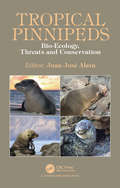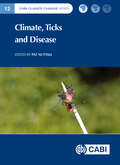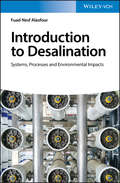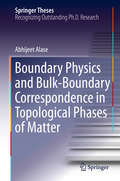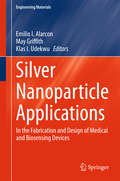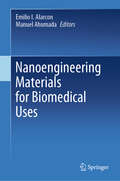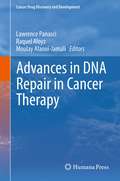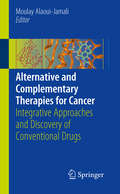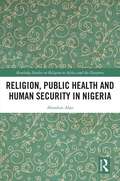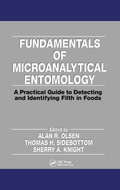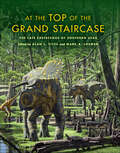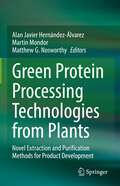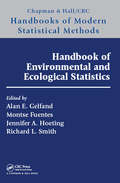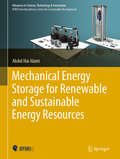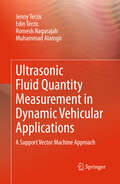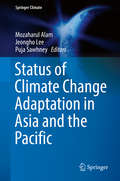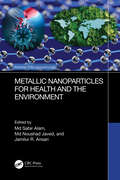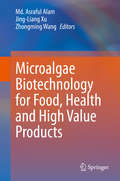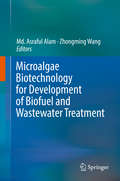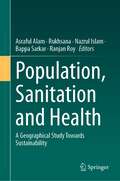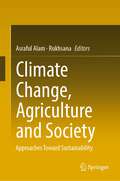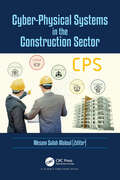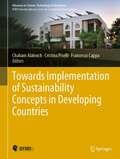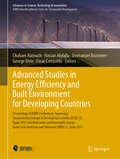- Table View
- List View
Tropical Pinnipeds: Bio-Ecology, Threats and Conservation
by Juan J. AlavaPinnipeds are a fascinating group of marine mammals that play a crucial role as apex predators and sentinels of the functioning and health of marine ecosystems. They are found in the most extreme environments from the Polar regions to the tropics. Pinnipeds are comprised of about 34 species, and of those at least 25% live permanently in tropical zones. This book reviews and updates current research on the biology, marine ecology, bio-monitoring, and conservation of tropical pinniped populations, including their behavior, anthropogenic stressors, and health. It also looks at challenges to be faced for the conservation of tropical pinnipeds, many of which are threatened species.
Climate, Ticks and Disease (CABI Climate Change Series #18)
by Saeed Alasmari Neil Alexander Abdelghafar Alkishe Reiko Arai Armanda Bastos Gervasio Henrique Bechara John Beier Giovanni Benelli Joshua Benoit Dennis Bente Richard Bishop Adrien Blisnick René Bødker Fernando Boinas Sarah Bonnet Nathalie Boulanger Alejandro Cabezas-Cruz Alexandre Rodrigues Caetano Cyril Caminade Jirí Cerny´ Roxanne Albertha Charles Ali Reza Chavshin Rosalind Cornforth Neil Coughlan Peter Cox Lauren Culler Milan Daniel Vlasta Danielova Mona Dehhaghi Maria Diuk-Wasser James P Duffy Olivier Duron Lars Eisen Rebecca Eisen Jana Elsterová Koray Ergünay Agustín Estrada-Peña Li-Qun Fang Natalia Fernández-Ruiz Erol Fikrig Serhii Filatov Durland Fish Janet Foley José De Fuente Roman Ganta Aysen Gargili Keles Robin Beat Gasser Abdul Ghafar Naftaly Githaka Lucy Gilbert Maryna Golovchenko Yuval Gottlieb Ernest Gould Jeremy Gray Libor Grubhoffer Gilles J. Guillemin Kayleigh M. Hansford Charles Hart John E. Healy Deborah Hemming Stephen Higgs Andrew Hoodless Yan-Jang S. Huang Bernard Hudson Chris Huntingford Peter Irwin Abdul Jabbar Nicholas Johnson Esther Kanduma Sirri Kar Maria Kazimirova Neil Kaye Thomas C. Kelly Lene Jung Kjaer Agatha Onyemowo Kolo Eduard Korenberg Nina Król Chi-Chien Kuo Timothy J. Kurtti Xavier De Lamballerie Patrick A. Leighton Hao Li L. Robbin Lindsay Wei Liu Geoffrey E. Lynn Ilya Maclean Ben J. Mans Maristela Martins de Camargo Karen D. McCoy Jolyon M. Medlock Ulrike G. Munderloh Atle Mysterud Sukanya Narasimhan Anna Obiegala Dasiel Obregón Alvarez Dr Nick H. Ogden Mari H. Ogihara Stefan Vilges Oliveira Charlotte Oskam Domenico Otranto Kennan J. Oyen Neha Pandey Hamed Kazemi Panahi A. Townsend Peterson John H. Pettersson Martin Pfeffer L. Paul Phipps Heather J. Plumpton Tatjana Pustahija Ram Raghavan Ryan O.M Rego Annapaola Rizzoli Isobel Ronai Franz Rubel Natalie Rudenko Benjamin Ruiwen Rufus Sage Abdallah M. Samy Gustavo Seron Sanches Isabel Kinney Santos Marcello Otake Sato Megumi Sato Richard Schloeffel Seyyed Javad Seyyed-Zadeh Ladislav Šimo Sunit Kumar Singh Daniel E. Sonenshine Morgan Sparey Frederic Stachurski Snorre Stuen Matias Pablo Szabó DeMar Taylor Mike Teglas Sam R. III Saravanan Thangamani Georgia Titcomb Attila J. Trájer Michael Turell Rika Umemiya-Shirafuji Dana L. Vanlandingham Laurence Vial Margarita Villar Richard Wall André B. Wilke G. R. Wint Jianhong Wu Zbigniew Zajac Xue ZhangThis book brings together expert opinions from scientists to consider the evidence for climate change and its impacts on ticks and tick-borne infections. It considers what is meant by 'climate change', how effective climate models are in relation to ecosystems, and provides predictions for changes in climate at global, regional and local scales relevant for ticks and tick-borne infections. It examines changes to tick distribution and the evidence that climate change is responsible. The effect of climate on the physiology and behaviour of ticks is stressed, including potentially critical impacts on the tick microbiome. Given that the notoriety of ticks derives from pathogens they transmit, the book considers whether changes in climate affect vector capacity. Ticks transmit a remarkable range of micro- and macro-parasites many of which are pathogens of humans and domesticated animals. The intimacy between a tick-borne agent and a tick vector means that any impacts of climate on a tick vector will impact tick-borne pathogens. Most obviously, such impacts will be apparent as changes in disease incidence and prevalence. The evidence that climate change is affecting diseases caused by tick-borne pathogens is considered, along with the potential to make robust predictions of future events. This book contains: Expert opinions and predictions. Global coverage of trends in ticks and disease. In-depth examination of climate change and tick distribution links. This book is suitable for researchers and students studying zoology, biological sciences, medical entomology, animal health, veterinary medicine, epidemiology, parasitology, and climate change impacts; and for those concerned with public health planning or livestock management where ticks and tick-borne pathogens pose a threat.
Introduction to Desalination: Systems, Processes and Environmental Impacts
by Fuad Nesf AlasfourOne book dealing with the fundamentals of thermal and membrane desalination systems and discussing their economical as well as environmental aspects. With a growing population, climate change and greater water demand, desalination has increasingly become a part of the solution to regional water scarcity - seawater desalination capacity has roughly doubled in the past ten years. Desalination has also begun to receive more attention in academia, with research focusing on improving energy efficiency and system robustness and lowering capital costs. With this book, an introduction is given to the basics and fundamentals of desalination systems. Both, thermal and membrane desalination systems, are covered and discussed in view of energy, exergy, economic and environmental aspects. In the beginning, Introduction to Desalination: Systems, Processes and Environmental Impacts describes multi effect evaporation, vapor compression and multi-stage flashing. Further chapters deal with common membrane-based separations like reverse osmosis and membrane filtration, forward osmosis, diffusion dialysis and pervaporation as well as thermo-osmosis, electrodialysis and electrodeionization. Subsequently, hybrid systems are discussed, and the economic analysis of such systems and their environmental impact are highlighted. Each chapter contains theoretical and practical examples and concludes with questions and problems for self-study. * Needed: Desalination has become a part of the solution to regional water scarcity and an introductory book in this field is urgently needed. * Balanced Approach: Presents the fundamentals of thermal and membrane desalination systems. * Learning Material: Each chapter includes exercises for self-study and Instructors can find teaching material online. Introduction to Desalination: Systems, Processes and Environmental Impacts is an important resource for master's students in engineering sciences, lecturers in chemical and mechanical engineering, engineers, environmental chemists, as well as process engineers, engineering scientists in industry, and environmental consultants.
Boundary Physics and Bulk-Boundary Correspondence in Topological Phases of Matter (Springer Theses)
by Abhijeet AlaseThis thesis extends our understanding of systems of independent electrons by developing a generalization of Bloch’s Theorem which is applicable whenever translational symmetry is broken solely due to arbitrary boundary conditions. The thesis begins with a historical overview of topological condensed matter physics, placing the work in context, before introducing the generalized form of Bloch's Theorem. A cornerstone of electronic band structure and transport theory in crystalline matter, Bloch's Theorem is generalized via a reformulation of the diagonalization problem in terms of corner-modified block-Toeplitz matrices and, physically, by allowing the crystal momentum to take complex values. This formulation provides exact expressions for all the energy eigenvalues and eigenstates of the single-particle Hamiltonian. By precisely capturing the interplay between bulk and boundary properties, this affords an exact analysis of several prototypical models relevant to symmetry-protected topological phases of matter, including a characterization of zero-energy localized boundary excitations in both topological insulators and superconductors. Notably, in combination with suitable matrix factorization techniques, the generalized Bloch Hamiltonian is also shown to provide a natural starting point for a unified derivation of bulk-boundary correspondence for all symmetry classes in one dimension.
Silver Nanoparticle Applications
by Emilio I. Alarcon May Griffith Klas I. UdekwuExploring the synthesis, characterization, surface manipulation, electron transfer and biological activity of silver nanoparticles, this book examines the fundamentals of the properties and synthesis of these particles. With a renewed interest in silver nanoparticles, this book addresses the need to understand their potential in industrial, medical and other applications. It is divided into six chapters, each written by an expert and providing a comprehensive review of the topic while detailing recent advances made in each specific area. These topics include surface plasmon band, synthesis and characterization, Surface-enhanced Raman spectroscopy (SERS) and plasmon resonance mediated processes, photocatalysis, biomedical applications and biological activity. It also presents the current state of the art, challenges and future trends of catalysis, sensing and biomedical applications. 'Silver Nanoparticle Applications' provides an invaluable reference work and introduction for chemists, biologists, physicists and biomedical researchers who are interested in exploring the uses and applications of silver nanoparticles. It is also intended for students, researchers and professionals interested in nanotechnology.
Nanoengineering Materials for Biomedical Uses
by Emilio I. Alarcon Manuel AhumadaThis book fills the gap between fundamental and applied research in the use of nanomaterials in biomedical applications, covering the most relevant areas, such as the fundamental concepts of the preparation of nanostructures and regulatory requirements for their safe use in biomedical devices. It also critically discusses what has been achieved in the field, and what needs to be urgently addressed and reviews the state-of-the-art medical uses of nanomaterials for treating damaged organs and tissues.Combining the expertise of clinical researchers working in the field of tissue engineering and novel materials, the book explores the main topics regarding the characterization of materials, specific organ-oriented biomaterials and their applications, as well as regulations and safety. Further, it also examines recent advances, difficulties, and clinical requirements in terms of human bone, cornea, heart, skin and the nervous system, allowing readers to gain a clear and comprehensive understanding of current nanomaterial use in biomedical applications and devices, together with the challenges and future trends.This book is a valuable tool for multidisciplinary scientists and experts interested in fundamental concepts and synthetic routes for preparing nanomaterials. It is also of interest to students and researchers involved in cross-disciplinary research in nanomaterials for clinical applications and offers practical insights for clinicians as well as engineers and materials scientists working in nanoengineering.
Advances in DNA Repair in Cancer Therapy (Cancer Drug Discovery and Development #72)
by Moulay Alaoui-Jamali Raquel Aloyz Lawrence PanasciA comprehensive review of the recent developments in DNA repair research that have potential for translational applications. The book explains in detail the various biological mechanisms by which cancer cells can circumvent anticancer therapy and limits its usefulness in patients. They also review the impact of such novel inhibitors of DNA repair mechanisms as methylguanine-DNA-methyltransferase. Also examined are inhibitors of other DNA repair enzymes such as PARP and DNA-PK. The book captures-for both cancer researchers and oncologists dealing with hallmark "relapse" or "drug resistance" phenomena on a daily basis-the many exciting new uses of DNA repair inhibitors, either alone or in combination with anticancer therapies.
Alternative and Complementary Therapies for Cancer: Integrative Approaches and Discovery of Conventional Drugs
by Moulay Alaoui-JamaliCancer is a common disease with a devastating impact on the physical and psychological well being of patients. The diagnosis of cancer brings upon many clinical challenges and questions for which clear and simple answers are not always provided by modern medicine. To date, only limited therapeutic options are available for patients with advanced cancer. The recent shift toward targeted therapies has improved substantially patient's survival, however, relapses are frequent and cure remains rare. This led patients and many health care managers to shift attention to the holistic approach of traditional medicine particularly preparations from herbal products to manage and alleviate the disease. Typically, herbal preparations contain single or multiple plant ingredients, including a number of potential active components. Yet, they remain classified as food supplements and thus are exempt from regulations on quality control and proof of efficacy that govern standard pharmaceuticals. Clinical evidence for many preparations is often based on non-documented or anecdotal evidence. In consequence, several preparations with unproven efficacy are circulating in the market with the fear of interference with standard cancer therapies and/or severe toxicity that some can generate, in addition to the unjustified economical burden to patients. Despite inconsistent and conflicting clinical results single molecules have been isolated from herbal preparations and many are exploited to develop potential novel agents. This has fostered the need to organize a set of timely, in-depth and up-to-date review covering the latest developments in alternative cancer management from a scientific and clinical perspective dedicated to the medical community and health care providers, as well as to patients and their families. This book brings the latest comprehensive cancer information and practical recommendations on the best documented practice of alternative therapies for cancer management put together by recognized experts in the fields of medical oncology, traditional medicine, and cancer pharmacology. It goes hand-in-hand with the patient's medical treatment options, quality of life issues, and more. The book is organized into four major sections: The first is an overview of the cancer syndrome by renowned medical oncologists from the USA and Europe. The second is a comprehensive description of traditional medicine by renowned experts from China and Germany. The third is an overview on the pharmacological impact of herb-based formulations on standard chemotherapy agents used in clinical practice. The fourth is a survey of cases reports from several hospitals with approved practice of alternative medicine. The book will feature simple definitions and essential information grouped in both medical and lay-term terminology, and straightforward illustrations related to human physiology, disease definition, scientific data on know and potential mechanisms of action, and preventive approaches. Finally, the book will feature collaboration of experts from China, India, USA, Canada, Germany, France, and other centres with recognized expertise in alternative/traditional medicine. This international cooperation is crucial to cover the complex topic of alternative therapies for cancer.
Religion, Public Health and Human Security in Nigeria (Routledge Studies on Remote Places and Remoteness)
by Abiodun AlaoThis book critically examines the intersection of religion, public health and human security in Nigeria. Focusing on Christianity, Islam, traditional religions and "intra-religious" doctrinal divergencies, the book explores the impact faith has on health-related decisions and how this affects security in Nigeria. The book assesses the connection between religion and five contemporary major health and medical issues in the country. This includes the issue of epidemics and pandemics such as the Covid-19 pandemic, vaccines, contraception, blood transfusion and the controversies associated with "miracle healing". In particular, the book explores situations where individuals have the power of choice but instead, embraces faith and religious positions that contradict science in the management of their health and, in the process, expose themselves and others to personal health insecurity. It investigates aspects of human security including the wider international ramifications of health issues, approaches to cures and the interpretation of causes of diseases, as well as the ethno-religious connotations of such interpretations. Exploring key issues that have brought religion into the politics of health and human security in Nigeria, this book will be of interest to students and scholars in the field of African Religion, African Politics, African Studies, public health, security, and Sociology.
Biology and Pathology of the Oocyte
by Alan Trounson Roger Gosden Ursula Eichenlaub-Ritter Alan Trounson Roger GosdenThe human oocyte, or egg, is the rarest and most rapidly aging cell in the body, and is essential for fertility. This book is about the development and pathology of the oocyte, and includes information on new technologies to manipulate, enhance, and control fertility. Leading world experts contribute essays on the basic and applied science of the egg, its clinical manipulation, and its pivotal role in reproductive medicine and biology.
Fundamentals of Microanalytical Entomology: A Practical Guide to Detecting and Identifying Filth in Foods
by ALAN R. OLSEN; THOMAS H. SIDEBOTTOM; SHERRY A. KNIGHTThis text offers insight into the practical applications of microanalytical entomology in the laboratory and in the field of consumer protection. This is the only guide that gives an overview of the subject from initial analysis of a product to interpreting significance of final results. Complete insect illustrations throughout and an insect fragment identification discussion covers all pests that are found in foods. Micrographs illustrate a complete reference on identifying types of hair contaminants found in various foods. Chapters are written by practicing regulatory experts.
At the Top of the Grand Staircase: The Late Cretaceous of Southern Utah (Life of the Past)
by Alan L. Titus and Mark A. LoewenThe Grand Staircase-Escalante National Monument is the location of one of the best-known terrestrial records for the late Cretaceous. Prior fieldwork confirmed the richness of the area, but a major effort begun in the new century has documented over 2,000 new vertebrate fossil sites, provided new radiometric dates, and identified five new genera of ceratopsids, two new species of hadrosaur, a probable new genus of hypsilophodontid, new pachycephalosaurs and ankylosaurs, several kinds of theropods (including a new genus of oviraptor and a new tyrannosaur), plus the most complete specimen of a Late Cretaceous therizinosaur ever collected from North America, and much more. The research documented in this book is rewriting our understanding of Late Cretaceous paleobiogeography and dinosaur phyletics. At the Top of the Grand Staircase: The Late Cretaceous of Southern Utah is a major stepping stone toward a total synthesis of the ecology and evolution of the Late Cretaceous ecosystems of western North America.
Green Protein Processing Technologies from Plants: Novel Extraction and Purification Methods for Product Development
by Alan Javier Hernández-Álvarez Martin Mondor Matthew G. NosworthyThis edited book provides the first comprehensive overview on conventional and emerging processing technologies for the extraction and purification of proteins and/or peptides from plant sources with a special focus on subsequent product development.The book opens with an introduction to the most conventional processing technologies used in industry today: the alkaline extraction followed by isoelectric precipitation, and air classification. The book also focusses on novel extraction and purification technologies, covering the most recent green emerging technologies based on enzymatic processes, solvents, high-pressure processing, barometric membrane technologies, and microwave-assisted extraction, among others. The final chapters bridge the gap between the presented methods and product development and highlight how these technologies can alter protein functionality and nutritional quality of the extracted protein, and thereby, impact human health.In the context of rising consumer interest in foods from plant-protein ingredients and the United Nations targets for Sustainable Development Goal 12 on ‘Responsible Consumption and Production’, this book will provide an indispensable resource for students, engineers and researchers in academia and industry, working in the area of food science, food technology and plant-based product development.
Handbook of Environmental and Ecological Statistics (ISSN)
by Alan Gelfand; Montse Fuentes; Jennifer A. Hoeting; Richard L. SmithThis handbook focuses on the enormous literature applying statistical methodology and modelling to environmental and ecological processes. The 21st century statistics community has become increasingly interdisciplinary, bringing a large collection of modern tools to all areas of application in environmental processes. In addition, the environmental community has substantially increased its scope of data collection including observational data, satellite-derived data, and computer model output. The resultant impact in this latter community has been substantial; no longer are simple regression and analysis of variance methods adequate. The contribution of this handbook is to assemble a state-of-the-art view of this interface. Features: An internationally regarded editorial team. A distinguished collection of contributors. A thoroughly contemporary treatment of a substantial interdisciplinary interface. Written to engage both statisticians as well as quantitative environmental researchers. 34 chapters covering methodology, ecological processes, environmental exposure, and statistical methods in climate science.
Mechanical Energy Storage for Renewable and Sustainable Energy Resources (Advances in Science, Technology & Innovation)
by Abdul Hai AlamiThe available literature on energy storage technologies in general, and mechanical energy storage in particular, is lacking in terms of both quantity and quality. This edited volume focuses on novel (yet uncomplicated) ideas that are currently part of the Energy Storage curriculum at the University of Sharjah, UAE. These techniques have been extensively researched and their prototypes are central to the undergraduate Energy Storage Lab that is associated with the course. Although ideally suited for wind energy storage, the techniques described are also suitable for renewable energy storage in general, and offer high two-way efficiency ratings.
Ultrasonic Fluid Quantity Measurement in Dynamic Vehicular Applications
by Muhammad Alamgir Edin Terzic Romesh Nagarajah Jenny TerzicAccurate fluid level measurement in dynamic environments can be assessed using a Support Vector Machine (SVM) approach. SVM is a supervised learning model that analyzes and recognizes patterns. It is a signal classification technique which has far greater accuracy than conventional signal averaging methods. Ultrasonic Fluid Quantity Measurement in Dynamic Vehicular Applications: A Support Vector Machine Approach describes the research and development of a fluid level measurement system for dynamic environments. The measurement system is based on a single ultrasonic sensor. A Support Vector Machines (SVM) based signal characterization and processing system has been developed to compensate for the effects of slosh and temperature variation in fluid level measurement systems used in dynamic environments including automotive applications. It has been demonstrated that a simple ν-SVM model with Radial Basis Function (RBF) Kernel with the inclusion of a Moving Median filter could be used to achieve the high levels of accuracy required for fluid level measurement in dynamic environments. Aimed toward graduate and postgraduate students, researchers, and engineers studying applications of artificial intelligence, readers will learn about a measurement system that is based on a single ultrasonic sensor which can achieve the high levels of accuracy required for fluid level measurement in dynamic environments.
Status of Climate Change Adaptation in Asia and the Pacific (Springer Climate)
by Mozaharul Alam Jeongho Lee Puja SawhneyThis volume provides an overview of the climate change adaptation objectives set, actions taken, and challenges faced by several countries in the Asia-Pacific region. The majority of the populations in this region struggle to make a living from subsistence agriculture, and livelihoods are highly dependent on natural ecosystem services which are likely to be severely affected by climate change. Cases discussed in this book highlight successes made by governments towards achieving adaptation objectives, and efforts required to overcome challenges. While significant economic advances have been made, the pace of growth has been slow to impact the lives of a majority of the people who live below the poverty line. The chapters highlight adaptation actions for protecting people and their livelihoods in priority sectors, maintaining food and water security, supporting socio-economic stability including poverty reduction, and climate risk management. This book also maximizes readers' insights into the knowledge gaps and limitations of stated adaptation goals, and the bottlenecks that hinder implementation in different regions.
Metallic Nanoparticles for Health and the Environment (Advances in Bionanotechnology)
by Md Sabir Alam Md Noushad Javed Jamilur R. AnsariMetallic Nanoparticles for Health and the Environment covers different routes of synthesis for metallic nanoparticles and their process variables. Both the functions and roles of these particles as a drug delivery system and diagnostic agent and other potential theranostic purposes against metabolic disorders, photocatalysis applications, as well as wastewater treatments, are discussed. The book compares the different properties of bulk metallic forms and their nanoparticulated forms. It discusses the mechanisms and impacts of different process variables in different synthesis routes, as well as emerging trends in clinics and so forth. Features: Covers different routes of synthesis to create metallic nanoparticles (MNPs) of different characteristics with reference to bulk forms of metals. Describes formulation parameters that have a significant effect on these MNPs including dimensions, morphology, mechanism, surface properties, and other characteristics. Discusses different roles and performances of MNPs in photothermal therapy, metabolic disorders, mechanisms in bacterial, fungal, and viral infections, and inflammatory pathways. Reviews the potential and emerging roles of different MNPs with site target delivery applications and genetic manipulation purposes. Examines the advantages and challenges of these MNPs against remediation of pollutants and toxicants, owing to their superior surface catalytic activities. This book is aimed at researchers and professionals in nanomaterials, pharmaceuticals, and drug delivery.
Microalgae Biotechnology for Food, Health and High Value Products
by Md. Asraful Alam Zhongming Wang Jing-Liang Xu"Microalgae Biotechnology for Food, Health and High Value Products” presents the latest technological innovations in microalgae production, market status of algal biomass-based products, and future prospects for microalgal applications. It provides stimulating overviews from different perspectives of application that demonstrate how rapidly the commercial production of microalgae-based food, health and high value products is advancing. It also addresses a range of open questions and challenges in this field. The book highlights the latest advances of interest to those already working in the field, while providing a comprehensive overview for those readers just beginning to learn about the promise of microalgae as a sustainable source of both specialty and commercial products. It offers a valuable asset for commercial algae producers, algae product developers, scientific researchers and students who are dedicated to the advancement of microalgae biotechnology for applications in health, diet, nutrition, cosmetics, biomaterials etc.
Microalgae Biotechnology for Development of Biofuel and Wastewater Treatment
by Md. Asraful Alam Zhongming WangThis book addresses microalgae, which represent a very promising biomass resource for wastewater treatment and producing biofuels. Accordingly, microalgae are also an expanding sector in biofuels and wastewater treatment, as can be seen in several high-profile start-ups from around the globe, including Solix Biofuels, Craig Venter’s Synthetic Genomics, PetroSun, Chevron Corporation, ENN Group etc. In addition, a number of recent studies and patent applications have confirmed the value of modern microalgae for biofuels production and wastewater treatment systems. However, substantial inconsistencies have been observed in terms of system boundaries, scope, the cultivation of microalgae and oil extraction systems, production costs and economic viability, cost-lowering components, etc. Moreover, the downstream technologies and core principles involved in liquid fuel extraction from microalgae cells are still in their early stages, and not always adequate for industrial production. Accordingly, multilateral co-operation between universities, research institutes, governments, stakeholders and researchers is called for in order to make microalgae biofuels economical. Responding to this challenge, the book begins with a general introduction to microalgae and the algae industry, and subsequently discusses all major aspects of microalgal biotechnology, from strain isolation and robust strain development, to biofuel development, refinement and wastewater treatment.
Population, Sanitation and Health: A Geographical Study Towards Sustainability
by Asraful Alam Rukhsana Nazrul Islam Bappa Sarkar Ranjan RoyThis book provides analyses of sanitation, health, population dynamics and demographic variables from different perspectives, including data science, statistics, modeling, economics and natural sciences, to inform sustainable decision making and policies related public health and hygiene and in mainly rural and impoverished areas. The structure is arranged into three broad sections: Part I, Population Dynamics, Environment and Society; Part II, Health, Livelihood and Policy Response; and Part III, Water, Sanitation, and Hygiene (WASH). The book makes recommendations for policymakers on designing and delivering social protection policies to deal with different aspects of water, health, sanitation, population, and hygiene, taking the needs of women and rural communities into special consideration. It also aims to educate students and early career researchers, to help them develop novel approaches for sustainability with environmentally sound practices.
Climate Change, Agriculture and Society: Approaches Toward Sustainability
by Asraful Alam RukhsanaThis book discusses emerging contexts of global warming and climate change, agricultural vulnerability and adaptation from local to global scale. Climate change, resilience in relation to agriculture and livelihoods and multi-dimensionality of various approaches are clearly taken into account by providing studies and perspectives on various methods and scales based on natural science to social science frameworks. This edited work contains chapters that are interdisciplinary, covering climate change, agriculture vulnerability, disaster impact, productivity efficiency, food security, livelihood resilience, land degradation, sustainability, in terms of plan and perform for transformation, sustainability and adaptation, including philosophy, change and economics, as well as the natural sciences. This book addresses the sustainable development goals to reduce the adverse impacts on agricultural productivity brought on by climate change and its adaptation and disaster risk reduction in developing and developed nations. Some of the assessed challenges include soil erosion, land use conversion, natural resource mismanagement, crop productivity decline and economic stagnation. This book covers important issues in the production and consumption of food in the past and present periods, agriculture, livelihood, and climate change, disaster risk management and society. All of these are under the threat of ongoing climate change and significant challenges to livelihood sustainability. The book is arranged into five broad sections: each part will cover a set of chapters dealing with a particular issue of the climate change, agriculture and society: approach toward sustainability. This book aims to attract attention of students, researchers, academician, policymakers and other inquisitive readers interested in different aspects of climate change, agriculture, livelihood and sustainability, particularly at local to global context.
Cyber-Physical Systems in the Construction Sector
by Wesam Salah AlaloulCyber-Physical Systems (CPSs) are mechanisms for monitoring and controlling processes using computer-based algorithms. In the construction industry, CPSs help to increase the viability of construction projects by reducing costs, time and management effort. This book aims to develop the fundamental concepts of construction project management associated with the CPSs and their applications within the modern construction industry in alignment with the scope of the Fourth Industrial Revolution (IR4.0). The book has been structured in a systematic way for easy understanding by construction industry researchers and academic faculty. The first part of the book helps readers to develop a basic understanding of the fundamental concepts of construction project management and CPSs. Followed by the second part about the CPSs implementation framework and understanding the operational concepts associated with the notion of IoT and Digital Twins within the construction industry. The third part of the book describes modelling/simulation techniques to develop the customised CPSs for construction project management. The concluding part provides an in-depth review of applications of CPSs, associated threats and security.
Towards Implementation of Sustainability Concepts in Developing Countries (Advances in Science, Technology & Innovation)
by Chaham Alalouch Cristina Piselli Francesco CappaThis book focuses on sustainability concepts in architecture and urban design, environmental issues, and natural resources. Today it has become essential to reduce carbon emissions, protect habitats, and preserve the delicate ecosystems of our planet. Accordingly, sustainable development has to be improved by decreasing the consumption of non-renewable resources, in order to help nature replenish itself.Further, it highlights the efforts that have been made by architects, environmentalists, engineers, students, planners and everyone in between in order to improve sustainability in various developing communities and countries.
Advanced Studies in Energy Efficiency and Built Environment for Developing Countries: Proceedings of IEREK Conferences: Improving Sustainability Concept in Developing Countries (ISCDC-2), Egypt 2017 and Alternative and Renewable Energy Quest in Architecture and Urbanism (AREQ-2), Spain 2017 (Advances in Science, Technology & Innovation)
by Chaham Alalouch Hassan Abdalla Emmanuel Bozonnet George Elvin Oscar CarracedoThis edited volume consists of three parts. It is a culmination of selected research papers presented at the second version of the international conference on Improving Sustainability Concept in Developing Countries (ISCDC) and the second version of the international conference on Alternative and Renewable Energy Quest in Architecture and Urbanism (AREQ), organized by IEREK in Egypt, 2017. It discusses major environmental issues and challenges which threaten our future. These include climate change impact, environmental deterioration, increasing demand for energy and new approaches for alternative renewable energy sources which became a necessity for survival. In addition to addressing the different environmental issues witnessed today, research presented in this book stressed on the need of sustainably shaping buildings and cities using renewable energy sources. Topics included in this book are (1) Resilience in the Built Environment, (2) Design for energy-efficient architecture and (3) Alternative and Renewable Energy Resources Quest in Architecture and Urbanism. The book is of interest to researchers and academicians who continuously aim to update their knowledge in these fields, as well as decision makers needing the enough knowledge to carry out the right decisions towards the benefit of the environment and society.
